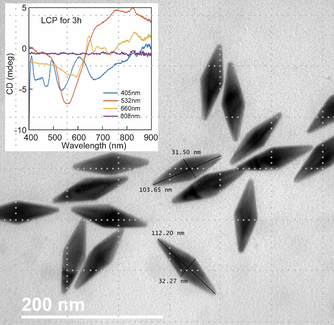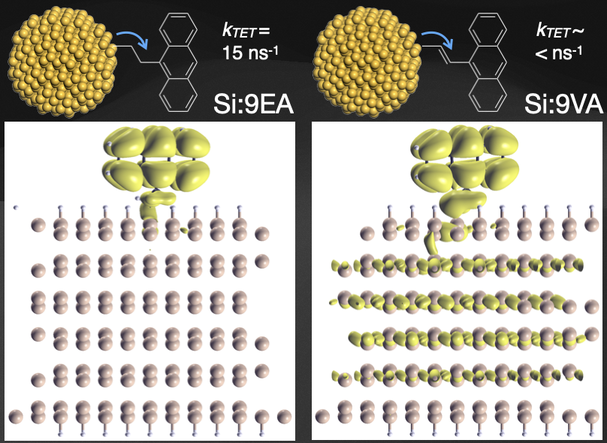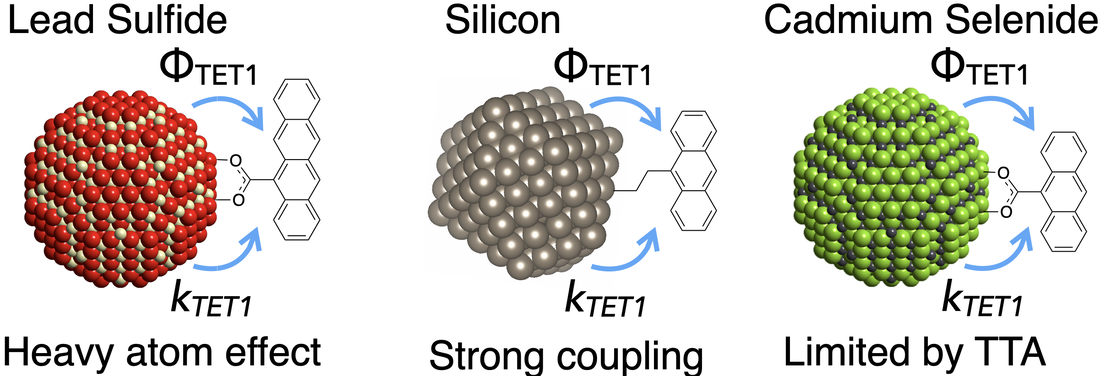This group focuses on the design, synthesis and characterization of novel hybrid organic-inorganic materials. Emphasis is on the synthesis of tailor-made organic ligands designed to control, enhance or mediate the optoelectronic properties of nanocrystals (NCs). The use of synthetic organic chemistry in ligand design enables desired properties to be embedded in a modular and scalable manner. These ligands allow the size, shape and material dependent properties of the NCs to be harnessed for energy, metamaterial and optoelectronic applications. The synthetic expertise in this group is complemented by time-resolved spectroscopy and thin-film current-voltage measurements. Specific research directions are outlined below:
Inducing Chirality at Visible Wavelengths

Chiral light (plane waves with circular polarization) is useful for initializing well-defined qubits for quantum computing, establishing anti-counterfeit measures, or performing enantioselective synthesis. There is a dearth of materials that absorb or emit chiral light strongly in the visible wavelengths. In the ultra-violet and infrared regimes, enantiomerically pure natural products and meta-materials achieve this goal. To address this paucity of materials, we design chiral organic helixes with strong resonances in the visible. We are also interested in using circularly polarized light captured by metal nanoantennas to initiate photodeposition to synthesize materials with strong circular dichroism (inset, top left) and circularly polarized luminescence. Metal nanocrystals like gold bipyramids (see transmission electron micrograph on the left) or silver nanorods are used as precursors.
Silicon Nanocrystals: Fundamental and Applied Research

Silicon is an earth abundant, benign, non-toxic material that forms the basis of the semiconductor industry. Despite the plethora of information on bulk Si, quantum confined silicon nanocrystals are not well-understood. In our lab, the room temperature, non-thermal plasma synthesis of silicon nanocrystals, in combination with synthetic and spectroscopic tools, allows the introduction of novel excited states. As shown on the left, a conjugated bridge can induce strong coupling between Si QDs and anthracene, resulting in high photon upconversion QYs from a delocalized excited state. This work is done in collaboration with Sean Roberts (UT Austin), Joel Eaves, (UC Boulder) and Lorenzo Mangolini (UC Riverside).
Designer Ligands for Enhancing Energy Transfer

This group discovered a new molecular-nanocrystal system for photon upconversion that can potentially have significant impact in several fields. Such a system can increase the efficiency of solar cells by 15%, and thus provide an inexpensive way to produce clean energy. If used for bioimaging, it may offer all the advantages of two-photon emission microscopy at a fraction of the cost. The key concept of this novel system is the use of a nanocrystal to absorb light and transfer the energy to a triplet state of a molecule. Two triplets then combine to emit light of higher energy. The beauty of this system is the tunability of both the nanocrystal light absorber and molecular fluorophore. This allows upconversion to be engineered between arbitrary wavelengths for various applications.